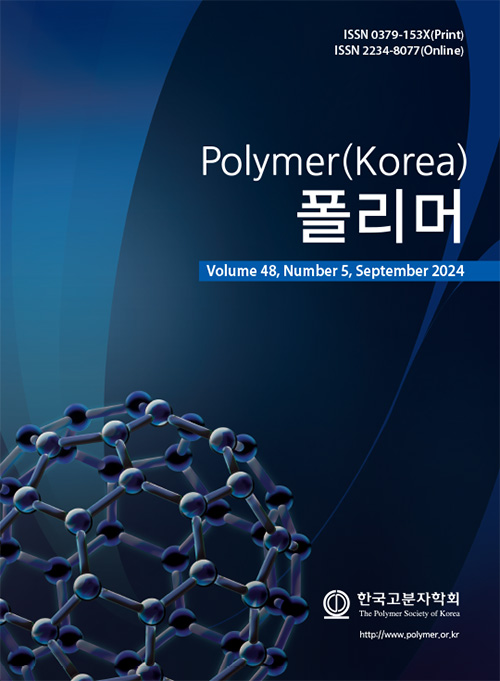- Preparation and Characterization of Injectable Biohybrid Thermogel Scaffold for Cartilage Regeneration
Seong Eun Kim# , Hye-Eun Shim*, **,#, Sun-Woong Kang**, ***,†
 , and Kang Moo Huh*,†
, and Kang Moo Huh*,† 
Departments of Materials Science and Engineering, Chungnam National University, 99, Daehak-ro, Yuseong-gu, Daejeon 34134, Korea
*Departments of Polymer Science and Engineering, Chungnam National University, 99, Daehak-ro, Yuseong-gu, Daejeon 34134, Korea
**Research Group for Biomimetic Advanced Technology, Korea Institute of Toxicology, Daejeon 34114, Korea
***Department of Human and Environmental Toxicology, University of Science and Technology, Daejeon 34114, Korea- 연골재생을 위한 주입형 바이오하이브리드 써모젤 스캐폴드 제조 및 특성분석
충남대학교 신소재공학과, *충남대학교 고분자공학과, **안전성평가연구소, ***과학기술연합대학원대학교 인체 및 환경 독성학과
Reproduction, stored in a retrieval system, or transmitted in any form of any part of this publication is permitted only by written permission from the Polymer Society of Korea.
Thermogels are highly useful as injectable hydrogel formulations due to their unique temperature-sensitive sol-gel properties, but their application in tissue engineering formulations has been limited by their poor mechanical properties and cellular affinity. In this study, a novel injectable biohybrid thermogel scaffold with enhanced mechanical properties and cellular affinity was prepared and evaluated by physical blending of hexanoyl glycol chitosan (HGC), a natural polymer-based thermosensitive hydrogel, with chondroitin sulfate (CS), an extracellular matrix-derived component. The resulting HGC/CS hydrogel retained the temperature-sensitive sol-gel properties attributed to HGC and exhibited suitable physicochemical and rheological properties as an injectable formulation. Furthermore, this biohybrid thermogel showed excellent potential as an injectable tissue engineering scaffold for effective cartilage regeneration due to low toxicity towards chondrocytes and enhanced cell affinity.
써모젤은 특정 온도에 반응하는 졸-젤 전환 특성으로 인해 약물전달을 위한 주입 가능한 하이드로젤 제형으로 유용성이 높으나 제한된 기계적 특성과 세포 친화성으로 인해 조직공학적 응용에는 한계가 있다. 본 연구에서는 천연고분자 기반 온도감응성 하이드로젤인 헥사노일 글리콜키토산(HGC)과 세포외기질 유래 성분인 콘드로이틴 설페이트(CS)를 물리적으로 혼합함으로써 기계적 특성과 세포 친화성이 향상된 새로운 주입형 바이오하이브리드 써모젤 스캐폴드를 개발하고 유효성을 평가하였다. 결과적으로, HGC/CS 하이드로젤은 HGC로부터 부여된 온도반응성 졸-젤 전환 특성을 유지하며 주입형 제형으로 사용하기에 적합한 물리화학적 및 유변학적 특성을 나타내었다. 또한, 연골세포에 대한 낮은 독성과 향상된 세포친화력을 기반으로 연골재생을 위한 조직공학용 주입형 하이드로젤로서의 우수한 잠재력을 확인하였다.
Keywords: biohybrid thermogel, injectable scaffold, hexanoyl glycol chitosan, chondroitin sulfate, cartilage regeneration.
- Polymer(Korea) 폴리머
- Frequency : Bimonthly(odd)
ISSN 0379-153X(Print)
ISSN 2234-8077(Online)
Abbr. Polym. Korea - 2023 Impact Factor : 0.4
- Indexed in SCIE
 This Article
This Article
-
2024; 48(5): 518-529
Published online Sep 25, 2024
- 10.7317/pk.2024.48.5.518
- Received on Mar 25, 2024
- Revised on May 23, 2024
- Accepted on May 28, 2024
 Correspondence to
Correspondence to
- Sun-Woong Kang**, *** , and Kang Moo Huh*
-
*Departments of Polymer Science and Engineering, Chungnam National University, 99, Daehak-ro, Yuseong-gu, Daejeon 34134, Korea
**Research Group for Biomimetic Advanced Technology, Korea Institute of Toxicology, Daejeon 34114, Korea
***Department of Human and Environmental Toxicology, University of Science and Technology, Daejeon 34114, Korea - E-mail: swkang@kitox.re.kr, khuh@cnu.ac.kr









 Copyright(c) The Polymer Society of Korea. All right reserved.
Copyright(c) The Polymer Society of Korea. All right reserved.